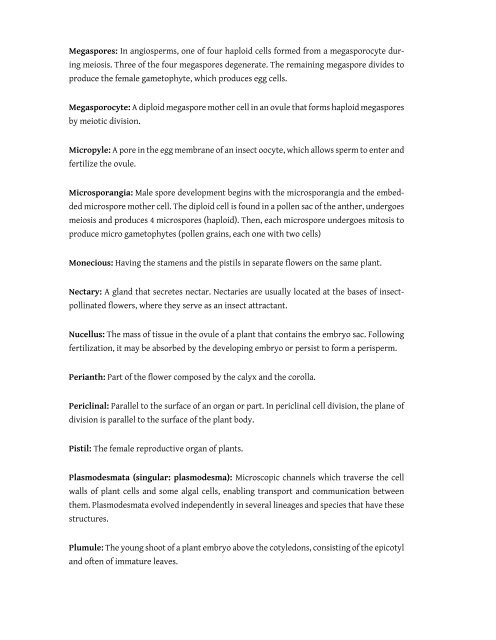Soybean and Bees
You also want an ePaper? Increase the reach of your titles
YUMPU automatically turns print PDFs into web optimized ePapers that Google loves.
Megaspores: In angiosperms, one of four haploid cells formed from a megasporocyte during<br />
meiosis. Three of the four megaspores degenerate. The remaining megaspore divides to<br />
produce the female gametophyte, which produces egg cells.<br />
Megasporocyte: A diploid megaspore mother cell in an ovule that forms haploid megaspores<br />
by meiotic division.<br />
Micropyle: A pore in the egg membrane of an insect oocyte, which allows sperm to enter <strong>and</strong><br />
fertilize the ovule.<br />
Microsporangia: Male spore development begins with the microsporangia <strong>and</strong> the embedded<br />
microspore mother cell. The diploid cell is found in a pollen sac of the anther, undergoes<br />
meiosis <strong>and</strong> produces 4 microspores (haploid). Then, each microspore undergoes mitosis to<br />
produce micro gametophytes (pollen grains, each one with two cells)<br />
Monecious: Having the stamens <strong>and</strong> the pistils in separate flowers on the same plant.<br />
Nectary: A gl<strong>and</strong> that secretes nectar. Nectaries are usually located at the bases of insectpollinated<br />
flowers, where they serve as an insect attractant.<br />
Nucellus: The mass of tissue in the ovule of a plant that contains the embryo sac. Following<br />
fertilization, it may be absorbed by the developing embryo or persist to form a perisperm.<br />
Perianth: Part of the flower composed by the calyx <strong>and</strong> the corolla.<br />
Periclinal: Parallel to the surface of an organ or part. In periclinal cell division, the plane of<br />
division is parallel to the surface of the plant body.<br />
Pistil: The female reproductive organ of plants.<br />
Plasmodesmata (singular: plasmodesma): Microscopic channels which traverse the cell<br />
walls of plant cells <strong>and</strong> some algal cells, enabling transport <strong>and</strong> communication between<br />
them. Plasmodesmata evolved independently in several lineages <strong>and</strong> species that have these<br />
structures.<br />
Plumule: The young shoot of a plant embryo above the cotyledons, consisting of the epicotyl<br />
<strong>and</strong> often of immature leaves.


